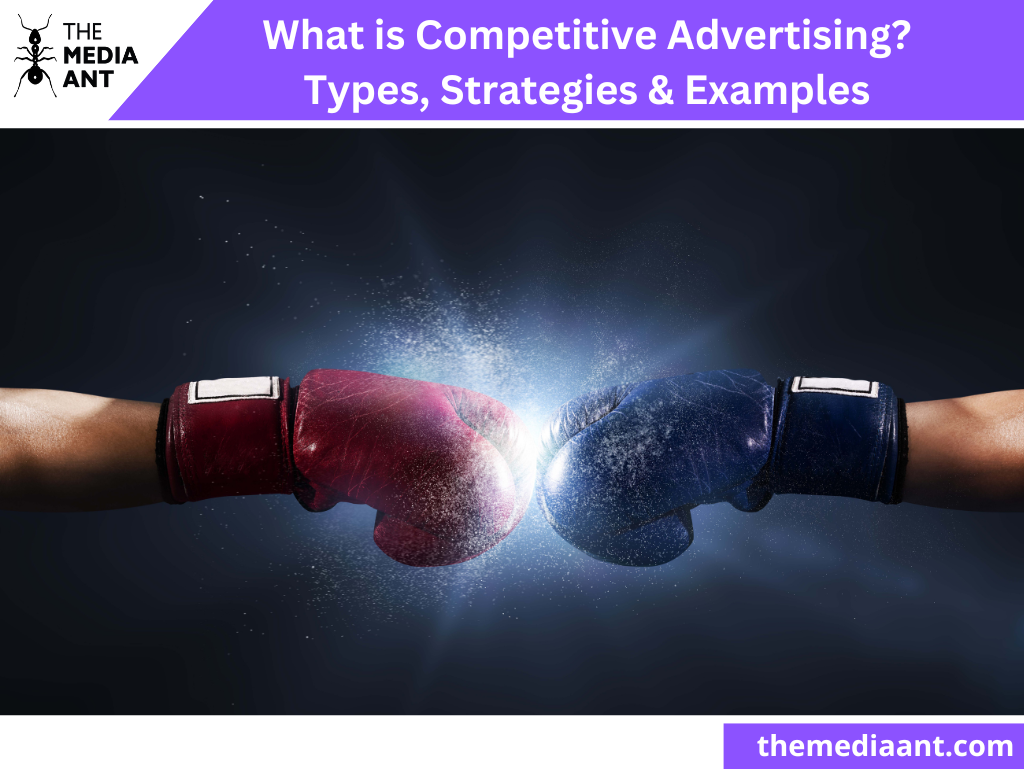Imagine two fast-food giants, their billboards side by side, each boasting the juiciest burger in town. You, the hungry commuter, gaze out of your car window, torn between these tempting titans. This, my friends, is competitive advertising at its finest. It’s the relentless pursuit of your attention, the battle for your loyalty, and the race to stay a step ahead of the competition.
In this blog post, we’re about to embark on a thrilling journey through the world of competitive advertising. We’ll unravel its intricacies, explore the diverse types that fuel this rivalry, and showcase awe-inspiring examples that demonstrate how brands go to war (metaphorically speaking, of course) to win your business. Get ready to witness the art, science, and drama of competitive advertising like never before!
What is Competitive Advertising?
Competitive Advertising, also known as comparative advertising, is a marketing strategy where a company directly compares its product or service to that of a competitor to demonstrate its superiority. This type of advertising aims to persuade consumers that the advertiser’s offering is better in some way, whether it’s in terms of quality, price, features, or any other relevant aspect.
In competitive advertising, businesses often highlight the advantages of their product over their competitors, which can include lower prices, higher quality, better performance, unique features, or customer testimonials. This strategy is employed to sway potential customers to choose their product over alternatives available in the market.
Competitive advertising can take various forms, including print ads, TV commercials, online campaigns, and more. However, it’s important to note that there are legal and ethical guidelines governing competitive advertising to ensure that the comparisons made are accurate and not misleading. Violating these rules can lead to legal consequences.
Why is Competitive Advertising important?
Competitive advertising is important because it can help businesses to:
Differentiate themselves from their competitors: By highlighting their unique features and benefits, businesses can use competitive advertising to show consumers why they are the best choice.
Increase brand awareness and consideration: When consumers are aware of a brand and consider it when making a purchase decision, they are more likely to choose that brand.
Competitive advertising can help to increase brand awareness and consideration, even if consumers are not actively looking for a product or service at that time.
Gain market share: By convincing consumers to switch from their current brand to yours, competitive advertising can help you to gain market share.
Drive sales: By generating interest in your product or service and encouraging consumers to take action, competitive advertising can help to drive sales.
Competitive advertising can also help to stimulate innovation and improve the quality of products and services. When businesses are competing with each other, they are incentivized to offer better products and services at lower prices. This can benefit consumers by giving them more choices and better value for money.
Types of Competitive Advertising
Competitive advertising is a marketing strategy in which a company directly or indirectly compares its products or services to those of its competitors. The goal of competitive advertising is to highlight the advantages and benefits of the advertiser’s offerings over those of their rivals. There are several types of competitive advertising:
Comparative Advertising
Comparative advertising is a strategy where a company directly compares its product or service to a specific competitor’s offering in its marketing campaigns. The intention is to highlight advantages, superior features, or better performance of their product in comparison to the competitor. This type of advertising aims to convince consumers that their product is a better choice.
Attack Advertising
Attack advertising is a more aggressive form of comparative advertising. It involves directly criticizing or attacking a competitor’s product or brand, often by highlighting its weaknesses, drawbacks, or failures. While this approach can be attention-grabbing, it also carries the risk of legal challenges and potential negative public perception.
Imitative Advertising
In imitative advertising, a company tries to emulate the style, messaging, or characteristics of a successful competitor’s advertising. This can include using similar visuals, slogans, or themes to create an association with the competitor’s brand in the minds of consumers. The goal is to benefit from the positive perception of the competitor’s brand.
Positioning Advertising
Positioning advertising doesn’t directly mention competitors. Instead, it focuses on creating a unique and positive image for the advertiser’s product or service. This can involve highlighting specific features, benefits, or values that set the product apart from others in the market. The aim is to establish a distinct position in consumers’ minds.
Price Comparison Advertising
Price comparison advertising directly compares the prices of the advertiser’s products or services with those of competitors. This is commonly used in industries where price is a significant factor in consumers’ purchasing decisions, such as retail and e-commerce. The goal is to showcase competitive pricing to attract cost-conscious consumers.
These different types of competitive advertising strategies can be effective in various contexts, depending on the industry, target audience, and competitive landscape. However, companies need to carefully consider the potential risks and ethical considerations associated with each approach, especially when employing aggressive tactics like attack advertising. Additionally, adhering to legal guidelines and maintaining a positive brand image is essential when engaging in comparative advertising.
Competitive Advertising Strategies
There are a number of competitive advertising strategies that businesses can use to differentiate themselves from the competition and drive sales. Here are a few examples:
Highlight your unique selling proposition (USP)
What makes your product or service different from the competition? What are its unique features and benefits? Once you know your USP, you can use it to create advertising that positions your product or service as the best choice for consumers.
Compare your product or service to the competition
This can be done directly or indirectly. For example, you could compare the features and benefits of your product or service to the features and benefits of a specific competitor’s product or service. Or, you could make more general claims about your product or service being superior to the competition.
Use testimonials and endorsements
Testimonials from satisfied customers and endorsements from experts can be very effective in persuading consumers to choose your product or service over the competition.
Offer a money-back guarantee or other risk-free trial. This can help to reduce consumers’ perceived risk and make them more likely to try your product or service.
Use humor or other emotional appeals
People are more likely to remember and respond to ads that are funny, heartwarming, or otherwise emotionally appealing.
Target your advertising carefully
Think about who your target audience is and what media channels they are most likely to consume. Then, place your ads in those media channels.
Benefits of Competitive Advertising
Competitive advertising can offer several benefits to companies looking to gain an edge in the marketplace and outperform their competitors. Here are some of the key advantages:
Market Differentiation
Competitive advertising helps your brand and products or services stand out in a crowded marketplace. By highlighting what sets you apart from competitors, you can create a distinct identity and attract the attention of potential customers.
Increased Sales and Market Share
Effective competitive advertising can lead to higher sales and a larger share of the market. When consumers perceive your product as superior or more valuable than the competition, they are more likely to choose it, contributing to revenue growth.
Consumer Education
Competitive advertising allows you to educate consumers about the specific advantages and benefits of your offerings. This is especially valuable when you have innovative features or superior quality that potential customers may not be aware of.
Consumer Confidence
You can build consumer confidence by providing evidence and information to support your claims in competitive advertising. Consumers are more likely to trust and choose products or services that are backed by data, testimonials, or comparisons.
Long-Term Brand Building
Competitive advertising isn’t just about short-term gains; it can also contribute to long-term brand building. Consistent messaging about the superiority of your offerings can help establish a strong and enduring brand image in the minds of consumers.
Competitive Advertising Examples
1. MAC vs. PC
To kick off this list, we can’t overlook one of the most iconic comparative advertising campaigns in history. Apple once promoted its Mac computers through a series of TV commercials that gave distinct personalities to the Mac and the PC, resulting in comical and contrasting portrayals. In these ads, the Mac exudes a laid-back and charismatic persona, while the PC appears dorky and overwhelmed.
In a particular commercial from this campaign, the PC falls ill with a virus—an issue Macs are known to be immune to. As the PC sneezes, struggles with tissues, and eventually faints from exhaustion, the Mac, charmingly played by Justin Long, remains composed and collected. Aside from conveying that Macs are resistant to viruses, the advertisement cleverly suggests that using a Mac can effortlessly elevate one’s cool factor.
2. Dove vs. everyone else
Dove chose to compare itself not to a specific competitor but rather to a generic representation of competitors. Their message is straightforward: while other lotions may be harsh on your skin, Dove is gentle and caring. The use of barbed wire in the advertisement reinforces this message.
There’s a valuable lesson to be learned from Dove’s approach. When you directly target a single competitor, some consumers may perceive your marketing as negative or malicious. This perception can have detrimental consequences, as the negative association in the minds of potential customers may overshadow your intended message. On the other hand, by comparing yourself to an anonymous blend of competitors, you can convey your value as a business in a memorable way while maintaining a positive reputation.
3. Wendy’s vs. McDonald’s
Breaking away from television advertisements, we have a unique example of comparative advertising in the form of a tweet. After the release of Marvel Studios’ “Avengers: Infinity War,” Twitter was inundated with memes related to the film’s dramatic ending (spoiler alert: Thanos turns half of all living creatures into dust). With its reputation for playful and unpredictable online interactions, Wendy’s social media team decided to join in on the fun.
The result? A tweet that was destined to go viral, depicting a McDonald’s Big Mac disintegrating into dust. While this image would have been humorous and relevant on its own, it was the caption that truly made it stand out: “[That feeling when] your beef’s still frozen.” For those not closely following the activities of multinational fast-food chains (which might be for the best), Wendy’s has built its brand around the use of fresh, never-frozen beef. In this instance, they chose to convey this message through a comparison with McDonald’s.
FAQs Related to Competitive Advertising
What is an example of competitive advertising?
An example of competitive advertising would be a soft drink company running an advertisement that directly compares the taste and quality of its product to a rival soft drink, showcasing why their product is superior in terms of flavor or refreshment.
What is the competitive stage of advertising?
The competitive stage of advertising is a phase in the advertising process where companies focus on differentiating their products or services from those of competitors. During this stage, companies often use comparative advertising to highlight their unique features, benefits, or advantages over rival offerings.
What media is used for competitive advertising?
Competitive advertising can be executed through various media channels, including:
Television: Television commercials that directly compare products or showcase superiority.
Print Media: Print ads in newspapers, magazines, or brochures that highlight competitive advantages.
Digital Media: Online ads, social media campaigns, and website content that emphasize product differentiation.
Radio: Radio ads that compare products or services and promote unique selling points.
Outdoor Advertising: Billboards and posters that showcase competitive advantages.
Direct Mail: Marketing materials sent to targeted audiences that emphasize product superiority.
What are the benefits of competitive advertising?
Competitive advertising offers several benefits, including increased brand differentiation, higher sales and market share, consumer education about product advantages, enhanced consumer confidence, and long-term brand building. It also aids in effective market positioning and provides valuable feedback for marketing strategies.





